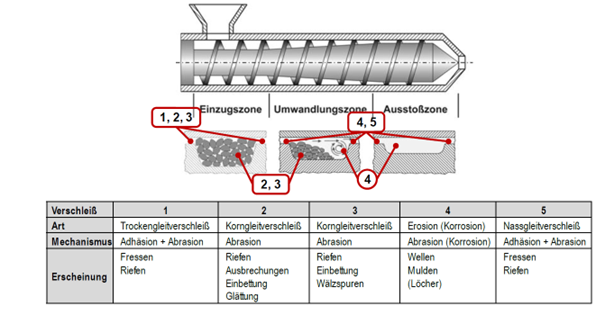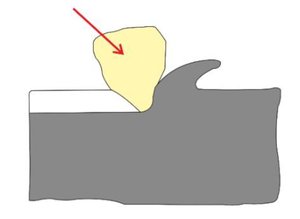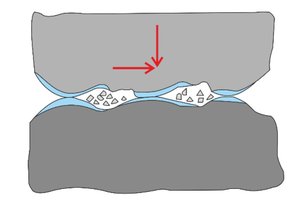Reliable Process through Wear Protection
These new requirements regarding components and materials are driven by:
- Changing qualities of raw materials due to increased recycled content lead to a higher degree of moisture in the process and heavier strain (Ref. 1)
- Bio-based polymers or natural filler materials result in increased corrosion and/or abrasion during processing (Ref. 2)
In addition, manufacturers of plastic products need to make their production more flexible and increase their efficiency to remain competitive in the international environment. Consequently, the stress on wear parts in processing machines is increasing:
- Frequent load changes due to smaller batch sizes cause higher stress on processing machines
- Increasing screw speed to increase throughput rates poses the risk of start-up on the barrel wall (Ref. 3)
- Increasing amounts of fiber reinforcements, fillers and additives trigger corrosion and abrasion
Stress does not increase to the same extent in all parts of the system. Wear mechanisms vary depending on the processing zone.
Wear is often a superposition of abrasion, adhesion and corrosion!
The tribological system of a plasticizing unit is used as an example to illustrate the basic types and mechanisms of wear:

Various factors play a role in the wear of machines in plastics processing: polymer type, temperature, pressure, screw speed, load changes, proportion of fillers, cleaning, etc. Studies by the German Plastics Institute have shown that approx. 40% of all wear-related failures are caused by adhesive wear (Ref. 5). In general, wear is mostly a superposition of abrasion, adhesion and corrosion and significantly affects the productivity of plastics processing machines.
Adhesion

If components in contact lie firmly on top of each other, the contact surfaces stick to each other as a result of adhesion. Particles are then sheared off during sliding. This results in holes and scale-like material particles, which often adhere to the sliding surface of the harder partner. This wear mechanism is called adhesive wear. Adhesive wear occurs when lubrication is inadequate. In unsuitable pairings, this quickly leads to seizure and ultimately to component failure.
Counter Measures

In order to minimize the damage caused by adhesive sliding wear, suitable materials must be found for the screw and barrel which exhibit good failsafe running properties under the specific ambient conditions. Alloys with a body-centered cubic lattice structure (bcc) or hexagonal dense packing (hdp) are generally more suitable than alloys with a face-centered cubic structure (fcc). In general, cobalt alloys are more resistant to adhesion than most nickel alloys. Recommendable alloys include Stellite™ 6 and Tribaloy™.
Abrasion

When hard particles of a lubricant or roughness peaks of one of the friction partners penetrate the surface layer, this results in scoring and micro-chipping. In the plastics processing industry, this type of wear is caused in particular by the addition of fillers, such as fibers or even color pigments.
Counter Measures

As a general rule, a favorable ratio (e.g. hard carbides in tough intermediates) between strength and toughness should be aimed for in metallic pairings. The hardness and volume fraction of large-area hard phases should be as high as possible. Coatings with hard phases such as tungsten carbide (WC) are also a possible solution. The smaller the grain size and hardness according to Mohs, the lower the wear erosion. Recommended alloys include Stellite™ 20, Deloro™ 60.
Corrosion

Corrosion describes the destruction of a solid body through an unintentional chemical or electrochemical action starting at its surface.Polymers containing chlorides (e.g. PVC) or fluorides (e.g. PTFE) can cause corrosion on components. This means that unwanted chemical or electrochemical reactions cause damage to the surface. Manufacturers of bioplastics (e.g. PLA) also recommend the use of corrosion-resistant materials.
Counter measures

If the focus is on corrosion protection, the complete screw can be made of a nickel-base alloyed with chromium (Cr) and/or molybdenum (Mo). Another viable material is Tribaloy™ which was developed in the 70's specifically for machining PTFE plastics. Recommended alloys include Tribaloy™, Deloro™ 50.
Deloro Wear Solutions offers a comprehensive range of components and services for rubber and plastics processing up to perfectly matched wear protection systems according to customer requirements. We are happy to plan and take over essential steps for you including basic material procurement, machine finishing and quality control. Our most popular solutions for the plastics industry include:
- Cast extruder screw blanks
- Ready-to-install, coated and machined components (screw elements, barrels, nozzles, extrusion dies, etc.)
- Nozzles for hot runner systems - bars or ready machined
- PTA welding equipment and filler metals that allow customers to coat new components or repair components on site
In many cases, Deloro has achieved a significant increase in service life for customers in demanding conditions through optimized wear and corrosion protection. Deloro also advises and accompanies you on the way to sustainable production with robust components.
Contact us
More about plastic processing
References
1. GEISELMANN, B. (2020) Interest grows in extruders designed for recycled plastics and bioplastics
2. JOMIN, T. (2020) A Methodological Outlook on Bioplastics from Renewable Resources
3. RUDSCHUCK, M. et al. (2016) , Deutsches Kunststoff-Institut, Verschleißuntersuchungen an schnelllaufenden Extrudern
4. KAMPER, S. (2019) Eisenbasierte intermetallische Hartlegierungen für den Verschleißschutz am Beispiel von Einschneckenextrudern
5. REINHARD, M. (1986) Untersuchungen zu den Notlaufeigenschaften verschiedener Werkstoffe bei einer Paarung mit Nitrierstahl. Vortrag DKI-Arbeitskreis "Verschleiß"
6. ZUM GAHR, K.-H. (1992) Reibung und Verschleiß: Ursachen - Arten - Mechanismen. In: Reibung und Verschleiß, Oberursel: DGM Informationsgesellschaft mbH,

